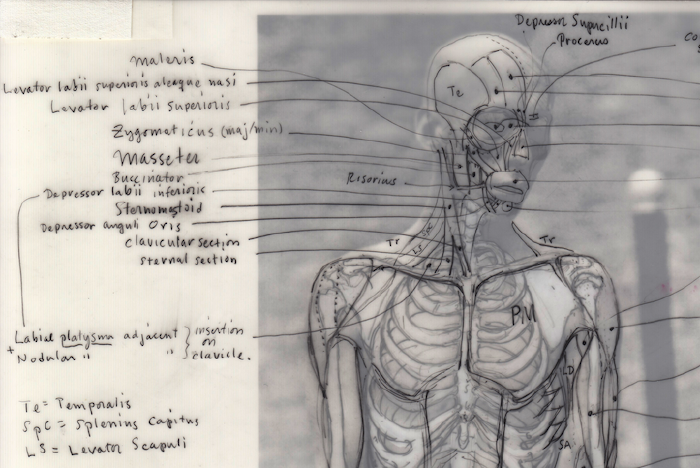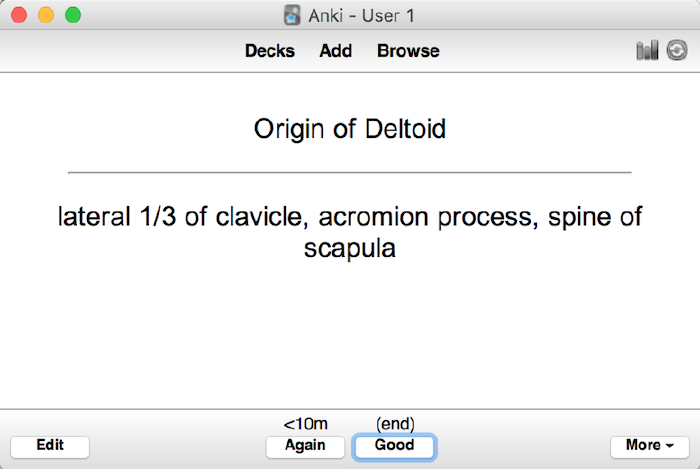Learning Muscular Anatomy
code clojure art emacs orgmode .....
Next: Painting and Time
Prev: Reflections on a Year of Daily Memory Drawings

A knowledge of the human form is vital for figurative artists. A detailed understanding of anatomy is especially helpful when working from life or constructing the figure from imagination.
Various approaches have been taken to learning artistic anatomy. While I'd rather not rob graveyards and do my own dissections, there are, fortunately, excellent anatomy books[1] available for the artist.
I have found the muscles harder to learn than the skeleton, so I developed the method outlined here, which involves reading, data entry, and memorization. Other methods include drawing muscles on tracing paper over figure drawings or photographs, or sculpting muscles atop a pre-formed skeleton. This practice supplements, but does not replace, those other methods.
A few key facts can be helpful to learn, for each of the important muscles (< 100 of them, roughly):
- Muscle name
- Origin of muscle (attachment point, stationary during contraction)
- Insertion of muscle (attachment point, moves during contraction)
- Function: what the muscle does
- What the muscle overlaps
- What the muscle is overlapped by.
These last two points can be helpful in constructing a mental model of the muscular forms and of the entire form they help to create.
I use the Anki flash card system as a tool for memorization. Anki uses a carefully designed model to set the timing of when you see individual cards, showing you ones you got wrong sooner, and gradually showing them less and less often as you learn.
For all the muscles you want to study, you can enter these key facts into a table, and then export the table into flashcards. The original Org file can be kept in Git under source control and shared with others, and presents a convenient overview of the entire corpus of data. Merely entering the data in the first place starts the memorization, and then each table field can be paired with the muscle name both "forwards" and "backwards" (fact->muscle and muscle->fact) as separate flashcards. Thus, for, say, 100 muscle names and the associated five facts per muscle, one has 100 x 5 x 2 = 1,000 flashcards.

There are Anki decks for muscular anatomy already available, but they tend to be large in size and have a medical rather than artistic context; also, finding and summarizing the information required to create the cards helps me learn.
I wrote a tiny Clojure program (GitHub repository here) to facilitate exporting the Org data into Anki, which accepts tab-separated lines. I run it whenever I add new muscles into my table.
Since Anki synchronizes with my phone, I can review whenever I have a short break. If I enter a few muscles a week, the data entry should roughly keep up with my memorization practice, and will then have all the relevant muscles memorized in well under a year with minimal daily effort… perhaps five minutes per day.
Sample program output
$ lein run
Function of Sartorius flexes, weakly abducts, rotates upper leg; flexes and medially \
rotates lower leg
Muscle w/ function flexes, weakly abducts, rotates upper leg; flexes and medially \
rotates lower leg Sartorius
Origin of Sartorius Just below tip of ASIS
Muscle with origin 'Just below tip of ASIS' Sartorius
Insertion of Sartorius Pes anserinus, on tibia
Muscle with insertion 'Pes anserinus, on tibia' Sartorius
Sartorius overlaps... Gracilis, Rectus Femoris, Vastus Medialis, Adductor Longus
Gracilis, Rectus Femoris, Vastus Medialis, Adductor Longus are overlapped by... Sartorius
Function of Deltoid flex arm forward, abducts outward, pulls backward
Muscle w/ function flex arm forward, abducts outward, pulls backward Deltoid
Origin of Deltoid lateral 1/3 of clavicle, acromion process, spine of scapula
...… and a sample flash card (top portion only is shown initially, with the answer below shown after a tap or keypress):

Workflow
- Clone the GitHub repository and
cdto the new directory; - Edit
resources/muscle-structure.org; - Export Org file to CSV (
org-table-export) in the same directory; - Run the program and save the output:
lein run > cards.txt; - Import
cards.txt(removing any previously-imported entries first) into Anki; - Memorize away!
- Repeat as new muscles are added.
Conclusion
After a few weeks of minimal effort (a lot less than my previous year-long project), I've added half a dozen or so muscles so far and have them pretty well down. Since the overlapping forms are included, one starts to flesh out one's three-dimensional understanding of the figure from the outset. (I recommend starting with the largest muscles first if you're not as familiar with them – e.g. pectoralis, gluteus maximum, rectus abdominis, etc.). This method is a bit personal, Emacs, Org Mode, Clojure, etc. not being standard artists' tools, but could be adapted to e.g. Excel or CSV files, or other programming languages, with minimal effort.
[1] See, for example, Human Anatomy for Artists: The Elements of Form by Elliot Goldfinger.